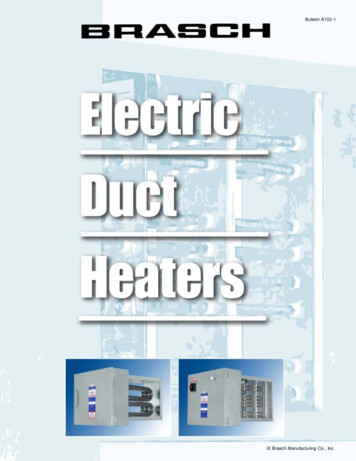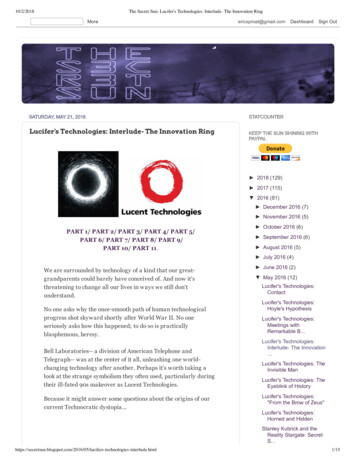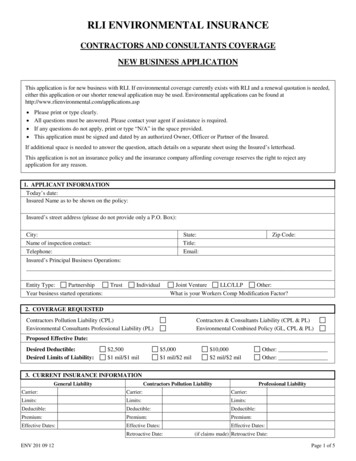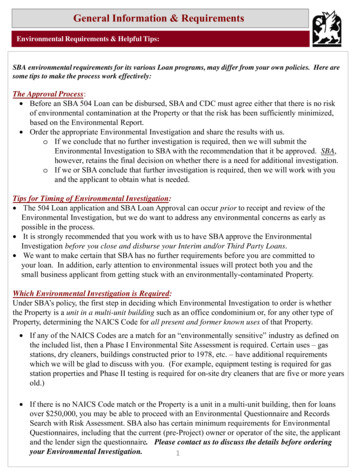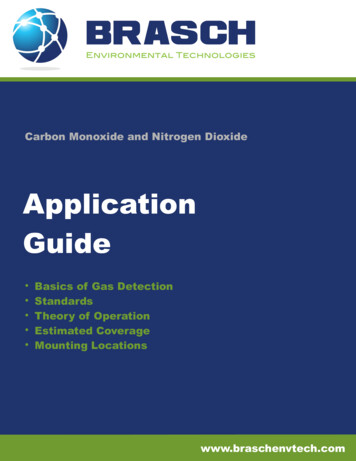
Transcription
Carbon Monoxide and Nitrogen DioxideApplicationGuide Basics of Gas DetectionStandardsTheory of OperationEstimated CoverageMounting Locationswww.braschenvtech.com
Basics of Gas DetectionWHO needs a gas detection system?Most cities have building codes that require gas detection systems in areas where toxicgases are produced. Even if local code does not mandate such a system, installing oneoften makes a lot of sense. There are many benefits, and everyone – building owners,tenants, workers, visitors, and even neighbors – can all take advantage of them.WHAT is a gas detection system?A gas detection system is a device or combination of devices that monitor the presence ofgases in an area. These systems can range from simple monitoring devices that warnusers of hazardous conditions to complex networks that can control ventilation equipmentand clear an area of any danger.WHEN is toxic gas a problem?High concentrations of toxic gas, or even prolonged exposure to low concentrations of toxicgas, always pose a threat. By the time a problem condition can be seen or smelt, it is oftenalready too late. Gas detection systems run 24/7 to continually ensure the safety of an areaand prevent serious problems by handling them while they are still manageable.WHERE are gas detection systems used?Carbon Monoxide is most commonly found in gasoline (petrol) engine exhaust whileNitrogen Dioxide is most commonly found in diesel engine exhaust. Parking garages, firestations, warehouses, factories, parcel facilities, loading docks, and automotive repairshops are just a few of the many places that are at risk from vehicle exhaust. Gasdetection systems can be used in places like these to reduce risk and enhance efficiency.WHY are gas detection systems beneficial?There are many benefits to installing a gas detection system beyond just improving healthand safety. These systems can intelligently turn on and off ventilation equipment asneeded – saving on the energy costs of running fans and on heating and air conditioningcosts from exchanging air of different temperatures. Furthermore, reducing the runtime offans minimizes noise pollution, meaning people are more likely to be more satisfied withtheir environment.1
StandardsRegulatory LimitsIn the United States, the three main agencies with regulations on hazardous gases areOSHA, NIOSH, and ACGIH – each with its own limits on exposure. Permissible Exposure Limit (PEL) is set by OSHA as the legal limit of chemicalsubstance or physical agent that an employee can be exposed toRecommended Exposure Limit (REL) is set by NIOSH as a recommendation for OSHAto adopt as the new PELThreshold Limit Value (TLV) is set by ACGIH as the daily level to which a worker may beexposed for his/her working lifetime without adverse health effectsEach of these limits can be broken down into three subcategories: Time-Weighted Average (TWA) concentration of gas in a worker’s breathing zone for an8-hour period during a 40-hour work weekShort-Term Exposure Limit (STEL) to a particular substance expressed as a TWAconcentration over a 15-minute period instead of 8-hoursCeiling (C) or maximum instantaneous concentration a worker can be exposed to withoutrespiratory aidCarbon MonoxidePEL – TWA:50 PPMCarbon MonoxideREL – TWA:35 PPMCarbon MonoxideTLV – TWA:25 PPMTLV – STEL: 400 PPMNitrogen DioxidePEL – STEL:1 PPMPEL – C:5 PPMNitrogen DioxideREL – STEL:1 PPMNitrogen DioxideTLV – TWA:3 PPMTLV – STEL:5 PPMBrasch LimitsAll Brasch Gas Detectors have adjustable limits to allow for flexible use in a variety ofenvironments and applications. Limits can be lowered below the legally required level foradded safety factor or raised to the limit to avoid excessive operation of ventilationequipment and the added cost that comes with it.2
Theory of OperationDetectionThe first step in protecting any environment from hazardous gases such as CarbonMonoxide and Nitrogen Dioxide is detection. Being aware of what gases are present andhow concentrated they are is critical to addressing any health and safety concerns that mayarise as a result of those gases. Brasch Gas Detectors are designed to give you thisknowledge by outputting gas concentration to a user-readable display and a computerreadable proportional output. This way you can see potential dangers before they evereven begin to pose a threat.Low AlertOnce the concentration of gas is known, action can be taken. Brasch Gas Detectorsautomate this process by actuating relays that can control ventilation systems and otherequipment. Based on the low alert threshold and delay set by the user, the detector willclose the low alert relay once the specified amount of gas is present and the specified timehas passed. Low alert is most often used to open louvers and turn on a low-speed fan,introducing fresh air, removing contaminated air, and returning levels of gas below a safelevel.High AlertIf gas concentration continues to rise and the factory-fixed high alert threshold is exceeded,the high alert relay will close. This relay is commonly used to engage additional fans orincrease the fan speed from low alert levels to circulate more air in an attempt to clear thearea of the hazard.AlarmOnce the detector has remained in the high alert state for 15 minutes, the alarm relay willclose and the internal buzzer will sound, indicating the gas concentration could not bereduced. The alert relay is typically used to activate additional warning equipment likealarms and strobes to inform occupants they need to evacuate.Additional ControlWhile Brasch Gas Detectors make it easy to monitor gases and maintain safeenvironments, sometimes additional control may be necessary. Every detector comes witha linear proportional output that can be used for even finer fan control using a VFD or forconnection to a Building Management System (BMS) to integrate with other automationsystems and enable logging of historical data.3
Other ConsiderationsWarm-UpAny time a detector is powered on, the sensors must first stabilize before accuratemeasurements can be taken. To accommodate this period of uncertainty, Brasch GasDetectors incorporate a short warm-up before commencing normal operation. Upon comingout of the warm-up phase, sensors have stabilized enough to reasonably protect againstdangerous concentrations of gas. For best results, detectors should be allowed to run for atleast two hours.Self-TestAll Standalone Brasch Gas Detectors are equipped with a self-test feature. By pressing the“ALM OFF/TEST” button within five minutes of applying power, the unit will run through ascripted test, sequentially turning on the indicator LEDs, closing the relays, and soundingthe buzzer. This test can be used to verify that all external equipment connected to thedetector is wired properly. Brasch Multi-Zone Control Panels do not have a self-test script,but they do have a built-in manual override. By entering into the programming menu, theuser can engage each zone’s indicator LEDs and relays, consequently verifying anyconnected equipment.Fail-Safe ConditionWhether there is a tripped circuit breaker, faulty wiring connection, or sudden power surge,Brasch Gas Detectors are designed to fail safely. In the event the detector loses power, thelow alert and alarm relays will close, activating any connected ventilation and warningequipment that still have power. This prevents the build up of gas in scenarios where thedetector, for whatever reason, can no longer monitor concentrations of hazardous gas.MaintenanceOngoing maintenance is essential to keeping any gas detector in peak working condition.All components and wiring should be regularly inspected for compliance with regulations aswell as to prevent wear from corrosion or degradation. Sensors should be bump-tested atleast once every year to ensure proper response to gas and recalibrated or replaced whenthe response is no longer within acceptable tolerance. All relevant personnel should betrained to operate, adjust, troubleshoot, and maintain both detectors and ventilationsystems. Keeping documentation on procedures, tests, results, and settings may help tominimize issues over the life of the detector.4
Estimated CoverageBrasch Gas Detectors are capable of covering 9000 ft 2 (836 m2) in areas with low ceilings and good aircirculation. As ceiling height increases and air circulation decreases, so too does the coverage area. Notethat detectors mounted on walls or in corners will see a reduction in the effective coverage area, regardlessof ceiling height or air circulation. For maximum coverage, place sensors a distance of one diameter awayfrom each other and one radius away from any walls or barriers. Use the information* below to helpdetermine coverage in your specific application.CeilingHeight(ft)AirChangesPer HourArea(sq. 5000-9000 ft2Diameter79.8-107.0 ftRadius39.9-53.5 ft* The numbers above are for estimation purposes only and do not necessarily reflect actual coverage capabilities. The customer assumes all liability for determining actual coverage in individual applications.5
Mounting LocationThe ability of the unit to efficiently sense the target gas depends greatly upon proper selection of themounting location. The unit monitors the area around it by sampling the air that passes by the sensor.Therefore, the unit should be positioned where it can sample air that contains a target gas concentrationrepresentative of the average value in that area.When determining the mounting location, give special consideration to the following guidelines: Use one sensor per target gas for each coverage area as determined on the previous page. Always prioritize locations with the highest occupation density. If using remote transmitters, do not locate any further than 1000 feet from the control unit. The types of gases each unit is designed to monitor have densities approximately equal to that of air.For maximum safety, mount the unit at the average breathing height.Avoid mounting locations that would not be representative of the average gas value in that area. Theseinclude but are not limited to locations near doorways, fans, ventilation inlets and outlets, and areas withhigh volume of air flow.Avoid locations that would allow direct contact with water. Mounting the unit near outside garage doorsmay allow rain to hit the unit when the door is open. Avoid locations that are directly in the outlet air vents of heaters or air conditioners. Avoid mounting locations with normal ambient temperatures below 5 F (-15 C) or above 104 F (40 C). Do not allow exhaust from engines to flow directly on the unit. Each unit is designed to sense gasconcentrations that are 300 to 1000 times less concentrated than the gas levels found in engineexhaust. Also, engine exhaust contains high levels of other components. These components canshorten the useful life of the sensor if they contact the sensor before being diluted by the room airvolume.Avoid mounting locations where the unit may be hit by passing vehicles. If the unit must be mounted inthese locations, provide a shielding cage around the unit for protection. Do not restrict the air flow to the unit housing. Do not mount the unit in a corner. Do not mount the unit near containers of chemicals such as gasoline, kerosene, alcohol, or othercleaning fluids. High level concentrations of these chemicals may be mistaken as the target gas by thesensor and cause false readings. Also, some welding gases may cause false readings.6
Save Time. Save Money. Save Lives.About UsBrasch Environmental Technologies, formerly Brasch Manufacturing, has been aleading designer and manufacturer of quality gas detection systems for over 25years. Brasch gas detectors are trusted by industry professionals and can be foundinstalled in a variety of buildings from firehouses to parking garages all across theUnited States and beyond. Our mission is to help make the environment a safer andmore comfortable place by protecting people from harmful gases. When customersinstall Brasch Environmental Technologies equipment, they have confidence theyhave the best products available, products that will far outlast their ber 2019 2019 Brasch Environmental Technologies, LLC
Brasch Limits All Brasch Gas Detectors have adjustable limits to allow for flexible use in a variety of environments and applications. Limits can be lowered below the legally required level for added safety factor or raised to the limit to avoid excessive operation of ventilation equipment and the added cost that comes with it. 2
